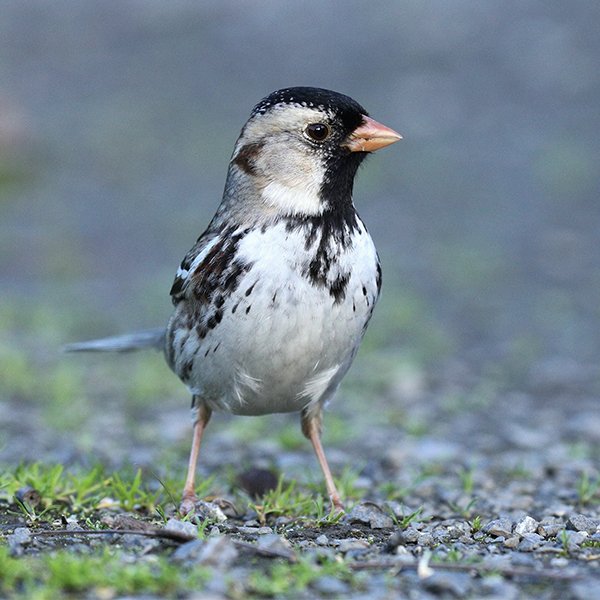Bird of the Month: Harris’s Sparrow
Written by Andy McCormick
Andy McCormick, Volunteer and Former Board President of Eastside Audubon
Harris’s Sparrow is an irregular winter visitor to the Pacific Northwest when it sometimes associates with other Zonotrichia sparrows in lowlands and around the Columbia plateau.
Harris’s Sparrow is North America’s largest sparrow which becomes evident when one drops into a flock of other feeding sparrows. The black hood and throat and large size immediately distinguish this sparrow from any other bird except possibly a Spotted or Eastern Towhee. The bold head pattern contrasts with the expansive white belly, which is brighter than that of any other sparrow and a black “checkmark” is visible at the back of the face in all plumages. Fine chestnut, black, and white streaking above its pale tan back and rump are also good field marks for Harris’s Sparrow (Wright).
Harris’s Sparrow shares the genus Zonotrichia with the White-throated (Z. albicollis), Golden-crowned (Z. atricapilla), and White-crowned (Z. leucophrys) Sparrows. Like these congeners Harris’s Sparrow displays muted plumage coloration in first-year birds. They are similar to winter adults in basic plumage which have less black and more brown around the face, and the crown may take on a scaly pattern. Immature birds have a white throat with black malar stripes (Norment, et al).
The song of Harris’s Sparrow is a sweet three-note pee-pee-pee heard mostly on the breeding grounds but may also be intoned on a warm winter day. As much as we might enjoy the song of Harris’s Sparrow, the bird has been named for its call. The species name querela is from the Latin for complaining. The bird’s call note is described as a “grating cheenk” (Holloway; Aversa, et al). Photo, videos, and vocalizations of Harris’s Sparrow can be found at the Macaulay Library.
100 YEARS OF SEARCHING
Harris’s Sparrow
Scientific Name: Zonotrichia querula
Length: 7.5”
Wingspan: 10.5”
Weight: 1.3 oz (36 g)
AOU Alpha Code: HASP
It took nearly a century after the bird was observed along the Missouri River by the European Thomas Nuttal in May 1834 for ornithologists to locate the nesting habitat of Harris’s Sparrow. Attempts by a variety of bird enthusiasts were futile until 1931 when a team of natural historians undertook a careful study of the habitat around Churchill in the Hudson Bay area. Harris’s Sparrow had been seen there in abundance in July of 1900. It took several days of five- to eight-mile hikes before the first nest was found on a mossy shrub in a cedar forest. In the next few days nine more nests were located (Wright).
Like most sparrows the nest of the Harris’s is a cup of moss, lichens, and twigs usually built by the female. Three to five pale green eggs are deposited, and development follows rapidly. Incubation lasts about two weeks and young leave the nest and fly in another 12 days. Both parents feed the young flies, caterpillars, bugs, and spiders.
A MIGRATING HEARTLAND BIRD
Harris’s Sparrow is a relaxed migrator and takes its time on the journey north in spring. This sparrow will begin its migration in early March but if it finds suitable feeding habitat it will stay for a few days before moving on, finally arriving on the breeding grounds around May 15. This slow movement may serve multiple purposes, one of which could be to give the north country tundra and boreal forest habitat time to warm up.
Its range is limited to a vertical corridor in the center of North America from the northern central plains of the Northwest Territories and Ontario to the plains of Nebraska south to Texas where it can feed on seeds of weeds and grasses and berries of various types (Kaufman). Flocks of Harris’s Sparrows will forage on the ground often scratching with their feet. East and west of the primary migration route Harris’s Sparrows are found in much lower numbers. In winter, Harris’s will associate with other Zonotrichia sparrows.
POPULATION STATUS
Harris’s Sparrow is one of the least studied birds in North America. Its remote breeding territory has made it difficult to complete even one survey of its population on the breeding grounds. However, some studies in its wintering habitat in the central United States provide some data. The bird is listed as yellow (declining species) on the Audubon Watch List and has a Population Trend score of 5 by Partners in Flight, indicating a drop of 50% in the bird’s population over the past 30 years (Norment, et al). Research is needed to determine the cause of this decline which could be associated with habitat loss in both the breeding and wintering locations.
Photo credit: Aaron Maizlish
References available upon request from amccormick@eastsideaudubon.org
Visit the Eastside Audubon Bird Gallery to read Bird of the Month articles covering over 200 bird species.



